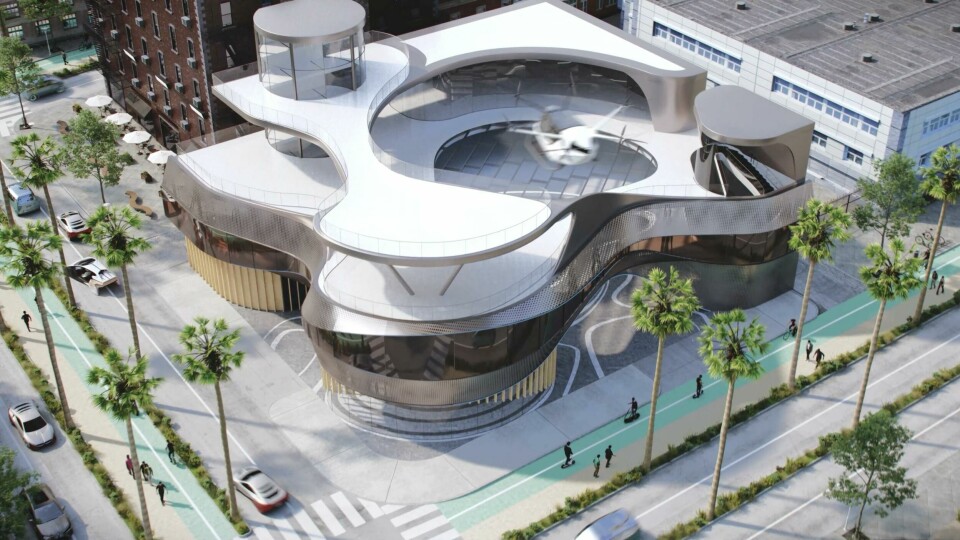
How auto and architecture crossover in the ‘Nth Space’
It may sound like science fiction, but the function of the car may be expanded in the coming years to a fusion of architecture, urbanism and transportation. Two design giants, BMW/Designworks, and Gensler Architects, step up to the challenge with a collaboration that radically re-envisions the car and the city. We speak to them about the results.
Our love affair with the car is a complicated one. We love the car, its form and design, and its performance, but we hate the slow-crawling mass of cars we have to struggle against in daily traffic. We love the convenience and accessibility the car provides, but we often decry the damage it has done to our cities, especially in treasured historic districts. We pay an enormous cost, directly or indirectly, to store our cars, at home or in a public car park.
But emerging innovations in both automotive and architectural spaces hold promise for a new relationship between our homes, our cars, and our work and leisure spaces. At Car Design News, we have previously explored these possibilities on a personal, residential level, but the larger public realm has been largely unexplored.
But just before the pandemic, BMW Group Designworks teamed up with Gensler Architects to research new opportunities in urban development that were somewhere between buildings and vehicles. They named this project Architecture X Mobility = A New Space Typology. Their teams worked throughout the pandemic and published their findings earlier this year.

We spoke with team leaders Neil Brooker, COO of Designworks in Santa Monica, California, and Jordan Goldstein, co-managing partner of Gensler’s Washington D.C. office, about the Architecture X Mobility project.
Car Design News: How would you summarise the Architecture X Mobility project?
Neil Brooker, BMW/Designworks (NB): The project emerged from a conversation Jordan and I had about the disruptions and opportunities happening in the automotive design and architecture professions, two disciplines that typically are working remotely from each other. The more we talked, the more we found commonalities and intersections. We thought bringing together the two professions would enable us to collectively reimagine how those intersection could come together. We wanted to “deconstruct” old assumptions and “reconstruct” new opportunities.
Jordan Goldstein, Gensler Architects (JG): Neil sums up the project very well. We wanted to combine our respective points of view, knowing Gensler is viewing the world through a spatial lens and Neil and his team are looking at this through the realm of the vehicle. One thing that was very important is the coming era of electrification in the automotive industry; electric vehicles break down the walls that once separated cars and occupiable spaces, and allowed us to think anew about so many things.
The “Nth Space” is an opportunity to envision a replacement for the petrol station
CDN: Were there any fundamental propositions or assumptions that laid the groundwork for the AXM project?
NB: There were three “provocations” that we often referenced. First, as parking becomes charging infrastructure, electric energy is available everywhere. How would people behave differently if electric energy is available everywhere in the city? Secondly, cars are designed for driving but on average are parked 90% of the day. What would cars look and function like if they were designed for the 90% of the day parked, if the driving was just a subset of their function? And finally, clean air technology allows mobility inside buildings; how are the buildings used if there is no border between the street and the building?
CDN: The video on the microsite illustrates petrol stations being replaced by “Nth Spaces” that combine different vehicle types and different building functions in new combinations of mobility and activity. Do you also see these places as centres for shared mobility exchange, electrical charging and storage?
JG: Yes, we do. Replacing petrol stations isn’t just a matter of switching from fuelling to charging. Petrol stations often occupy very valuable real estate, both horizontal and vertical. We often say that the petrol station is located on the corner of Main and Main, meaning that these stations are located at prime locations in the city and are very attractive for a number of use cases. Mobility exchange, storage and charging will certainly all be a part of that.
We were looking at re-imagining vehicle storage to make it more functional
NB: The “Nth Space” is an opportunity to envision a replacement for the petrol station — and also other ICE vehicle support facilities like oil change stations, tune-up stations and so forth. It also envisions a solution for a mobility exchange hub: cars, micromobility vehicles, and urban air mobility vehicles. We already see these hubs starting to emerge in cities like Los Angeles. But it also allows for the emergence of spaces that are neither work nor home, a “third” space — an “Nth Space” — a place for gathering in new ways. We thought of yoga, coffee, work and many others.
Also reconsidered was the single use parking structure. The idea of warehousing cars all day is a notion that we find outdated. But if you turn this concept on its head, and make the cars a part of the space, their functionality is greatly increased and the former parking structure is a multi-use place. It means re-thinking the car, and its functions. In many ways the new car will mirror our current connected and electrical devices that are an essential part of our lives. Can the car be a private, connected space within in a public place? And not just cars; other forms of transportation can be rethought as well.
JG: We were looking at re-imagining vehicle storage to make it more functional. If you can use your car as personal work space, a retreat, or a small meeting space, the matter of storage suddenly becomes a completely different concept — vehicles as part of a usable space within a facility. Again, addressing the “90 percent” Neil mentioned earlier.
CDN: Is autonomy critical to the design and success of the “Nth Space”, especially as shown in the opening video on the site?
NB: We’re a long way from autonomy as recent developments have shown, but probably some sort of governance or guidance system should be in place for a space where vehicles and people are in close proximity and, as we’ve discussed, interact in some ways. But is autonomy fundamental to Nth Spaces? I’m not sure I would go that far. It just depends on how it is designed.
CDN:Does the “Smart City” connect to these “Nth Spaces” ?
JG: Definitely. Not just municipalities, but institutions, academia and corporate campuses where an integrated workday is being developed. A smartphone app interface could track the parking, charging, and working place, a desk or meeting area. Businesses and people are evolving in their thinking to become more connected to their context. And so, it’s logical for the “Nth Space” to be a digital node on the network, as well as a physical one.
CDN: Are “Nth Spaces” strictly an urban design opportunity? Or could they be found in other areas outside the central city?
JG: There is certainly an opportunity to look at the “Nth Space” in different contexts, not only urban contexts, but suburban and even rural situations and question what those could be, where value could be added. What does an “Nth Space” look like in a rural context? If you travel between urban cores, you may need to stop and recharge. What does that look like and how does it fit into the overall pattern of your workday or leisure travel?
The “Nth Space” allows for a middle ground between going to the office without spending a couple of hours commuting, or working at home with its distractions
NB: One of the things that is pivotal to the “Nth Spaces” is the charging of the car. How do you spend that twenty or thirty minutes? Is it in the car? At a nearby café or workspace? How is value added to this activity, and who adds it?
Right now, charging is related to expensive electric cars, which are owned by a wealthy demographic. We need to plan for charging for everyone, those who will drive more modest electric cars, and even apartment dwellers, an endeavor that could be a more community-oriented service.

CDN: During the pandemic, new working patterns, including work from home, have emerged. But many employers now want to see workers back in the office, if for no other reason, corporations are paying a lot of money for real estate. How does the “Nth Space” help resolve this conflict?
JG: There’s a lot of discussion around return-to-work issues, and not everything is decided yet. But the “Nth Space” could find its way to an integration into a vertical structure that is mixed use — maybe workspaces, maybe housing, maybe a combination of all. The “Nth Space” could the base, with flexible uses that might change over time.
The video shows vehicles including flying taxis as well as pedestrian spaces. The experience of a flying taxi dropping off passengers on a rooftop and then offering a range of experiences in the descent down to a multi-modal transfer space might be very powerful.
The Nth space creates “meeting equity” that increases productivity. And this could be an architectural space or a vehicular space
NB: We are having the same discussions here at Designworks about workers returning to the workplace. It’s a good conversation, but that’s not the real issue. The real question is “How do I maximise the productivity of our workers and my team?” This is where the “Nth Space” can be of real value. Checking into a meeting — real or virtual — at an “Nth Space” equipped with technology not available at your home gives you an “equity” that might not be available just taking a zoom call at the dining room table at home.
Also keep in mind that the “Nth Space” allows the potential for a middle ground between going to the office without spending a couple of hours in the commute, or working at home with its distractions.
JG: That “equity” question is something we are dealing with everyday here at Gensler, and with our clients, especially as you have a mix of on-site teams and remote workers. Having a quality “Nth Space” that may not be the home office can still be effective and desirable. This creates “meeting equity” that increases productivity. And this could be an architectural space or a vehicular space.

Also, wouldn’t it be amazing to bring these technologies — touch screens, gestural controls, haptics, “shy tech’ — into the horizontal and vertical surfaces of architecture, including team rooms or meeting spaces. But there’s a technology gap that has yet to be bridged. One of the beauties of this collaboration is that we can ask, “What if there wasn’t a gap?”
What if there was a fluidity of materials and technologies in addition to the fluidity of space, how different could places and spaces and objects be?
CDN: So architecture and vehicles, which were totally different realms in the past, now seem to be headed towards a confluence of technology and function. The MINI Urbanaut concept, for instance, could be a vehicle, or a clubhouse, or a meeting room. Traditional architecture may fuse with vehicles to form new building/vehicle fusions. What possibilities do you see here?
NB: Architecture and mobility designed together allow for a new integration of the two. The “Blurred Boundaries” chapter on the AXM website (below) outlines some of the possibilities. A classroom for instance, that is mobile and can travel to a park or place to study.
It’s easy to limit the discussion about the car to the its design, its shape, its surfacing. But the beauty of the AXM study is that there’s a bigger story that we can look at
JG: I was reading recently about the aging of America’s school infrastructure. Imagine if one of the solutions was a mobile classroom that can travel and be combined together to create new schools. The “Nth Space” idea becomes a new, more fluid way to think about a school campus.
It would allow a campus that is not permanently wedded to a site, and would greatly accelerate the timetable for replacing aging school buildings. It could be resident on a site for a short amount of time or a few years, and then move on. Layer in the technologies we have discussed, and suddenly there’s a new exciting model for educational facilities — an “Nth Space”.
CDN: Some final thoughts on “Nth Spaces”?
JG: Early in the project, Neil shared with me an interior of a concept vehicle. I didn’t see it as a vehicle, but rather as a space I wanted to occupy for something other than driving. That’s a powerful idea and exactly what I wanted “Nth Spaces” to become: a new kind of space.
NB: It’s easy to limit the discussion about the car to the its design, its shape, its surfacing, its performance, what the car can do. But the beauty of the AXM study is that there’s a bigger story here that we can look at, so that we can break out of our existing paradigms of what we think of as car design. We must go much broader, wider in our thinking, and have better conversations about the future.
